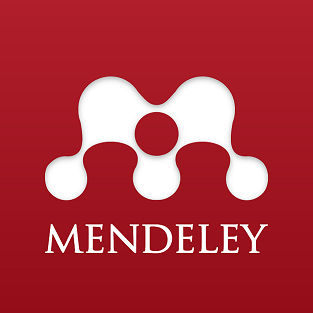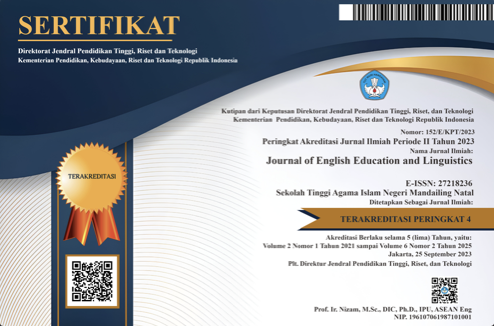A DISCOURSE ANALYSIS OF PRIMARY SCHOOL ENGLISH TEACHING ARGUMENTS
DOI:
https://doi.org/10.56874/jeel.v5i1.1708Keywords:
Discourse analysis, language policy, primary educationAbstract
This study delves into the complex and contentious debate over language policy in primary education, focusing on the inclusion of English language instruction. Using a discourse analysis approach, the study delves into multifaceted arguments and counterarguments related to adopting English as a primary language of instruction in early childhood education. A qualitative descriptive research design with content analysis and discourse analysis techniques is used in the methodology. A Content Analysis Worksheet and a Transcription Template are among the research tools used to analyze YouTube videos about the removal of English as a mandatory subject in Indonesian primary schools. Findings reveal a range of viewpoints among stakeholders, including educators, government officials, and citizens, with regional perspectives from Bali emphasizing the practical importance of English in a tourism-centric environment. The discussion highlights the importance of clear communication, consideration of regional contexts, balancing academic requirements, and long-term planning in shaping effective language policies in primary education.
References
Baker, C. (2011). Foundations of bilingual education and bilingualism. Multilingual Matters.
Bonacina-Pugh, F. (2020). Legitimizing Multilingual Practices in the Classroom: The Role of the ‘Practiced Language Policy.’ International Journal of Bilingual Education and Bilingualism, 23(4), 434–448. doi: 10.1080/13670050.2017.1372359.
Chiswick, B. R., & Miller, P. W. (2005). Linguistic distance: A quantitative measure of the distance between English and other languages. Journal of Multilingual and Multicultural Development, 26(1), 1-11.
Cummins, J. (2000). Language, power, and pedagogy: Bilingual children in the crossfire. Multilingual Matters.
Cushing, I. (2021). ‘Say It like the Queen’: The Standard Language Ideology and Language Policy Making in English Primary Schools.” Language, Culture and Curriculum, 34(3), 321–336. doi: 10.1080/07908318.2020.1840578.
De Costa, P. I., Curtis A. G., & Li, W. (2022). Problematizing EMI Language Policy in a Transnational World. English Today, 38(2), 80–87. doi: 10.1017/S026607842000005X.
Fraenkel, J. R., Wallen, N. E., & Hyun, H. H. (2012). How to design and evaluate research in education. McGraw-Hill.
Grin, F., & Vaillancourt, F. (1999). The economics of bilingualism. In Handbook of the Economics of Education (Vol. 3, pp. 557-598).
Hornberger, N. H. (1997). Bilingual education and bilingualism. In N. H. Hornberger (Ed.), Sociolinguistics and language education (pp. 35-67). Multilingual Matters.
Jenkins, J. (2007). English as a lingua franca: Attitude and identity. Oxford University Press.
Mahsar, L. (2020). “Pembelajaran Bahasa Inggris Menggunakan Content-Based Instruction (CBI) Dalam Meningkatkan Kemampuan Berbahasa Di Sekolah Tinggi Pariwisata Mataram.” Media Bina Ilmiah, 16(July), 1–23.
Phillipson, R. (1992). Linguistic imperialism. Oxford University Press.
Ricento, T. (2005). Problems with the 'language-as-commodity' metaphor in language education policy. In J. W. Tollefson & A. B. M. Tsui (Eds.), Medium of instruction policy (pp. 105-124). Lawrence Erlbaum Associates.
Saputra, R. (2022). Pengembangan Modul Elektronik Pada Mata Pembelajaran Bahasa Inggris Materi Family Tree Sebagai Sumber Belajar Siswa. E-Modul Pembelajaran Bahasa Inggris Untuk Siswa SMPN 1 Takengon 6.
Savski, K. (2020). Local Problems and a Global Solution: Examining the Recontextualization of CEFR in Thai and Malaysian Language Policies. Language Policy, 19(4), 527–547. doi: 10.1007/s10993-019-09539-8.
Spolsky, B. (2004). Language policy. Cambridge University Press.
Srirahayu, M., Rochmiyati, S., & Khosiyono, B. H. C. (2023). Digitalisasi Bahan Ajar Supplementary Berbasis Ajaran Tri-N Untuk Mengembangkan Kompetensi Bahasa Inggris Siswa Sekolah Dasar. Tuladha : Jurnal Pendidikan Dasar, 2(2):164–93. doi: 10.30738/tuladha.v2i2.15958.
Sutrisno, F. Z., & Salehcah, S. (2021). Local Content Curriculum Model for Early Childhood Scientific Learning. JPUD - Jurnal Pendidikan Usia Dini 15(1), 81–100. doi: 10.21009/jpud.151.05.
Swara, G. R., & Assidik, G. K. (2022. Analisis Wacana Kritis Model Teun A. Van Djik Pada Pidato Menteri Pendidikan Dan Kebudayaan Dalam Rangka Hari Pendidikan Nasional 2020. Jurnal Onoma: Pendidikan, Bahasa, Dan Sastra 8(1), 22–39. doi: 10.30605/onoma.v8i1.1507.
Tari, E., & Hutapea, R. H. (2020). Peran Guru Dalam Pengembangan Peserta Didik Di Era Digital. Kharisma: Jurnal Ilmiah Teologi, 1(1), 1–13. doi: 10.54553/kharisma.v1i1.1.
Tollefson, J. W. (2002). Language policies in education: Critical issues. Lawrence Erlbaum Associates.
UNESCO. (2003). Education in a multilingual world. UNESCO Publishing.
Downloads
Published
Issue
Section
License
All articles published in the Journal of English Education and Linguistics are licensed under a Creative Commons Attribution-ShareAlike 4.0 International (CC BY-SA) license. This means anyone is free to copy, transform, or redistribute articles for any lawful purpose in any medium, provided they give appropriate attribution to the original author(s) and Journal of English Education and Linguistics, link to the license, indicate if changes were made, and redistribute any derivative work under the same license.
Copyright on articles is retained by the respective author(s) without restrictions. A non-exclusive license is granted to the Journal of English Education and Linguistics to publish the article and identify itself as its original publisher, along with the commercial right to include the article in a hardcopy issue for sale to libraries and individuals.
Although the conditions of the Creative Commons Attribution-ShareAlike 4.0 International (CC BY-SA) license do not apply to authors (as the copyright holder of your article, you have no restrictions on your rights), by submitting to the Journal of English Education and Linguistics, authors recognize the rights of readers and must grant any third party the right to use their articles to the extent provided by the license.

This work is licensed under a Creative Commons Attribution-ShareAlike 4.0 International License.








